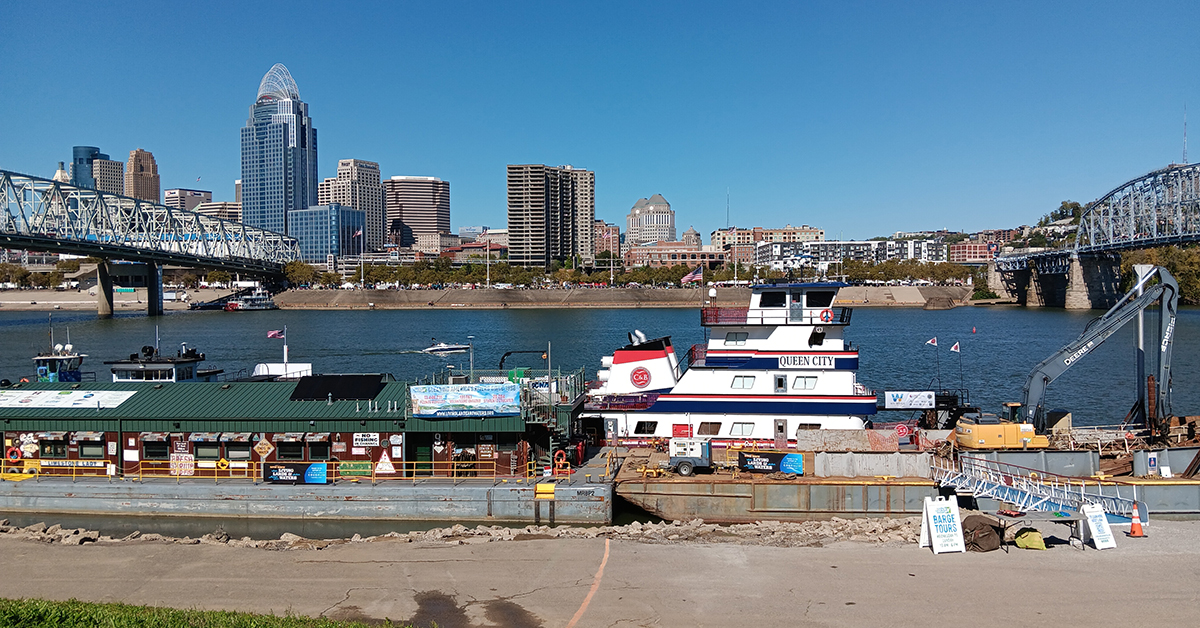It’s been an exciting year for Living Lands & Waters (LL&W). The organization has spent the year hosting and participating in cleanups all over the country, and morale is high.
The nonprofit, started in 1998 by Chad Pregracke, is an “industrial strength” organization dedicated to protecting and cleaning the rivers and surrounding environment. To date, LL&W has removed more than 14 million pounds of trash, with the help of nearly 140,000 volunteers and more than 30,000 students. Since its founding, LL&W has cleaned 31 rivers in 23 states and has hosted more than 1,428 community-based cleanups.
“This year’s been great,” Pregracke said. “We’ve been doing tons of cleanups all over. There’s been so much happening so fast.”
The 2025 season began with LL&W’s annual Alternative Spring Break (ASB), held in Memphis, Tenn. While most college students spend their spring break traveling or with family, the students who attend ASB spend their week off helping the community and joining LL&W in removing litter from surrounding lakes and rivers. More than 2,500 students have taken part in ASB and removed more than 1.8 million pounds of trash since its inception. This past spring, 142 students from 15 universities were part of ASB, removing nearly 132,620 pounds of trash from McKellar Lake in Memphis.
“It’s been a really good season,” Pregacke said. “We have a great team of people.”
LL&W is passionate about connecting with students outside of river cleanups as well. The Mississippi River Institute (MRI), LL&W’s floating barge classroom, is currently docked in St. Paul, Minn., where it has been hosting workshops for high school upperclassmen. Students aboard the MRI spend the morning learning about all the diverse career opportunities the Mississippi River has to offer from industry professionals and volunteers. Students engage in both presentations and hands-on activities to explore careers in engineering, biology, agriculture, management, finance, ecology and more. Since its launch last fall, the MRI has gained traction, hosting more than 1,500 students for workshops and classes.
“We’ve been hitting our stride with it,” Pregracke said. “It’s been awesome. It’s really been gaining a lot of momentum.”
With the help of Upper River Services, the classroom barge will head to the Quad Cities in late November to spend the winter and spring before traveling to St. Louis for the 2026 summer/fall semester.
“They’ve been awesome hosts,” Pregracke said about Upper River Services. “I can’t tell you how much they have done logistically and just helping us in every way. They’ve been fantastic.”
According to Pregracke, most cleanups of late have been focused on the Ohio River. Pregracke mentioned a cleanup with CLIF Bar as one of the highlights of the year. While most cleanups take place on a single day, the event with CLIF Bar spanned four days, and teams recovered 10,000 pounds of garbage.
“They’re just fantastic people,” Pregracke said. “We’ve been working [with CLIF Bar] for about 10 years. They come for an extended period of time and work with us, especially this time of year. It’s very rewarding, and you get to really meet people for longer than a day.”
Pregracke also cited cleanups with Ford Motor Company as other memorable moments this year.
“We’re working with a bunch of different Ford plants around the Midwest, and they’re helping us in Kansas City, Detroit and Memphis,” Pregracke said. “It’s been great. I couldn’t say enough.”
The work doesn’t end as the cold months approach, either, with cleanups continuing. Pregracke noted that work with the organization’s excavator will resume in cities such as Cincinnati and Louisville until December, uncovering large debris such as cars, barrels, boats and tires from the riverbeds.
“We’ll be running our excavator since the river level is low, pulling out cars and bigger things,” Pregracke said. “Barrels, cars, boats, anything big is what we grab this time of year when the water is at this level.”
LL&W’s work doesn’t stop at the riverbanks. The organization is just as focused on conservation and ecological impacts on land as it is on the water. The organization leads efforts to clear invasive plant life, and LL&W’s Million Trees Project has been planting trees to help “protect, preserve and restore” rivers and watersheds since 2007. LL&W’s goal of planting one million trees was surpassed in 2016 with 2,321,009 million trees planted to date. LL&W also distributes saplings to farmers, parks and other communities in the Midwest and Eastern regions.
“We gave away over 175,000 hardwood trees this year, mainly oaks,” Pregracke said.
When there isn’t a cleanup or workshop to host, LL&W takes part in events around the country, including the Inland Marine Expo (IMX), as well as hosting organizations and sponsors on the classroom barge. The National Waterways Foundation recently held a board meeting on the barge, and the organization also hosted the Cargill family, where speakers presented on the impact of invasive species, the river and its importance to the Cargill business.
“It’s a good group of people to have on there,” Pregracke said.
To learn more about LL&W and how to volunteer, visit www.livinglandsandwaters.org/how-to-help.
Featured image caption: A view of the Living Lands & Waters Mississippi River Institute barge moored on the Newport, Ky., riverfront during the America’s River Roots Festival. (Photo courtesy of Living Lands & Waters)



